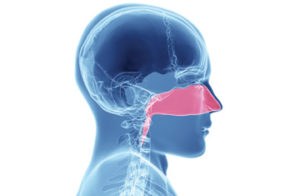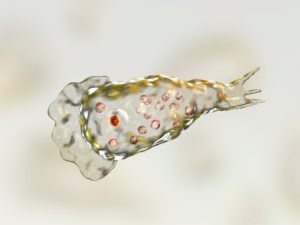What are Naegleria and why are they of concern
Naegleria are free-living amoeba (a microscopic free-living single-celled organism) commonly found in warm freshwater and soil. More than 40 species of Naegleria have been identified, some of which are thermotolerant (heat tolerant) and able to grow at temperatures as high as 46°C. One of the thermophilic species Naegleria fowleri, the only type that can infect humans, can cause primary amoebic meningitis (PAM) an often fatal disease of the central nervous system. The route of exposure is when water containing the Naegleria fowleri organisms is inhaled through the nasal passages. Typical water-related activities which can lead to exposure include when people swim, dive or fall into water containing Naegleria fowelri, when children play under sprinklers or with hoses using undisinfected water, or when infected water is inhaled to cleanse the nasal passages. The amoebae travel up the nose to the brain where they infect and destroy brain tissue.
The challenge of Naegleria
Naegleria are a challenge to manage because they are able to exist in three different forms, trophozoite, flagellate, and cyst. Under favourable conditions which are typically warm, nutrient rich and aquatic environments, they exist in the trophozoite form and are able to infect and also to reproduce. If pH or ionic changes occur surrounding the organism, the trophozoite can transition to the more mobile flagellated form. If the environment becomes depleted of nutrients, cold, or dry, Naegleria can transition to the cyst form which is more protected and makes them much more resilient in the environment. They are then able to change back to the trophozoite form when the conditions become favourable again. The Trophozoite form is the only form in which Naegleria are able to infect and reproduce.

Management of Naegleria risks in drinking water systems
The following points are the main considerations regarding management of risks related to Naegleria fowleri:
- The Australian Drinking Water Guidelines state that tap water systems where water temperatures are seasonally above 30°C or consistently above 25°C should be considered at risk of Naegleria fowleri. In Western Australia, a more conservative approach is taken and tap water systems where water temperatures are seasonally likely to exceed 20°C are considered to be at risk of Naegleria fowleri. Systems where thermophilic Naegleria has been detected previously are also at risk.
- The chlorine residual should be maintained at 0.5 mg/L or above throughout the distribution system to all outlets. A disinfectant monitoring program should be developed based on a site-specific risk assessment.
- Ensuring that the water distribution systems are designed, operated and maintained to minimise the opportunity for sediments to accumulate (which may harbour Naegleria cysts) and water to stagnate (which may lead to loss of disinfectant residual).
- Development of a monitoring program which includes temperature profiling and monitoring for thermophilic amoeba (including thermophilic naegleria species), along with suitable incident response protocols to guide action in the case of detection. Thermophilic amoeba testing is conducted as a positive result is indicative conditions are suitable for naegleria proliferation and act as an early warning sign that naegleria may present within the system.
- Suitable chlorine levels are also required in aquatic facilities (based on disinfectant agent used and facility type) to control Naegleria fowleri. Advice also needs to be given to users of untreated and process water where there is a risk of exposure or inhalation of infected water to ensure that Naegleria fowleri hazards are understood and also what behaviours may place users at risk of infection.
How Ecosafe can help
Ecosafe understands well the processes which can be used to minimise the risks from Naegleria fowleri posed to consumers and users of water. Ecosafe can assist by:
- Conducting a risk assessment to determine what measures can be put in place to minimise risks posed by Naegleria fowleri in your systems
- Development of site specific disinfectant residual management procedures and provision of associated compliance software to drive the all-important implementation
- Development of monitoring programs to track your Naegleria risks
- Carrying out field assessments of your systems to determine where your system is most at risk to Naegleria growth
- Providing field support in addressing c.
Contact us online or call 1300 73 93 73
Connect with us on Facebook
